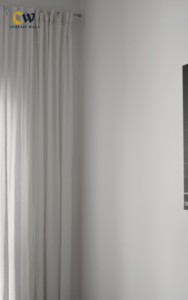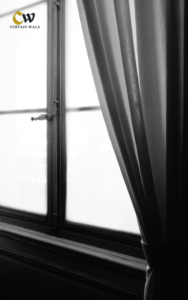
What probably comes to mind when you think of blackout curtains is how they use their light blocking abilities. These flexible types of blinds have gained a lot of acceptance recently due to their ability to darken the room for sleeping in the evening. As we progress through this guide, we’ll take a closer look at the materials and structure that are used in the construction of blackout curtains.
Structure of blackout curtains
In fact, blackout curtains are not your typical window treatment. These are specially engineered with the ability to reduce light penetration almost a hundred percent, making them useful in bedrooms, home theaters and such related areas. But the question is, what specifically are they made of, especially now that new products have come on the market?
Multiple layers for maximum light blocking
Most blackout curtains have multiple layers, typically three or four, each serving a specific purpose:
Face cloth: It is responsible for being the outermost layer that is seen when coming into a room. It is made of polyester, cotton or can be blended and is available in a variety of designs and colors to suit a particular locality.
Blackout Lining: Considered the highlight of the show, this layer is named for its

light-blocking function. It is, as a rule, made of a dense, closely woven fabric of comparatively heavy material, coated with a material such as varnish to make it opaque.
Foam Layer: One or two materials of high quality blackout curtains are insulated by a thin layer of foam for the purpose of sound deadening.
Support: The outer layer that is at the back is usually made of light-colored material that protects the curtains from UV radiation and fading.
Secret Sauce: Light-Blocking Technology
Functionality is the most basic reason for blackout curtains and it is provided by unique light-blocking features. This usually includes one or more of the following:
Tightly woven fabric: The blackout lining fabric used is made of tightly packed fibers so that there is very little space through which light can pass.
Special Coatings: Many blackout curtains are laminated with an acrylic black, opaque coating that enhances its ability to block light.
Reflective Support: Some of these curtains have a white or silver coating on the back side which actually bounces light towards the window and thus does not let the light in.
Common Materials Used in Blackout Curtains
Although specific materials can vary, here are some of the most common fabrics used in blackout curtains:
Polyester: Often used because the fabric is hard wearing and crease resistant and is a fairly economical fabric. Blackout polyester curtains are sometimes coated for greater effectiveness in light blocking purposes.
Cotton: Cotton potential blackout curtains have a natural and breathable feel and for this reason, they have a soft contact with the skin; They are also eco-efficient. They can be blended with synthetic fibers to improve the strength of the fibers.
Velvet: Velvet is really thick and maintains a luxurious feel, so if it’s backed by blackout material, it can block out most of the light.
Suede: Another thick fabric that comes with a blackout lining so it adds style as well as functionality.
Microfiber: This synthetic material is flexible, fairly strong, and does a very good job of keeping out light, especially when densely woven or treated with a black-out layer.
Beyond light blocking: other benefits
In the case of blackout curtains the material used for curtains offers much more than light management. They may also provide:

Thermal insulation: Multiple layers can also help control the temperature of a room, with the ability to lower the temperature in the summer while simultaneously raising it during the winter.
Sound Reduction: The thick fabrics that are used in making these furniture pieces can also help in reducing external noise and thus provide a quiet environment.
Energy efficiency: They can also increase energy costs because blackout curtains reduce heat by insulating your windows.
Choosing the Right Blackout Curtains
Thus, when choosing blackout curtains, one should consider the type of material used in making the curtains, their color and whether they include certain features like thermal or sound proofing. Always keep in mind that darker colors and denser fabrics are generally better at keeping out light.
Blackout curtains can be freely described as multi-layered fabrics made from fabrics that have been given a special treatment and are effective in the exclusion of light to a great extent. Whether you’re a light sleeper, work night shifts, or are a movie aficionado who needs a dark room, knowing what they’re made of can solve the problem.
FAQs:
-
Q: Are blackout curtains and room darkening curtains the same thing?
Although similar, they are not exactly the same. Blackout curtains are designed to block 99-100% of light, while room darkening curtains typically block 95-99% of light. Blackout curtains often have additional layers or treatments for maximum light blocking.
-
Q: Can I wash blackout curtains?
Many blackout curtains are machine washable, but it's important to check the care label first. Some may require dry cleaning to maintain their light-blocking properties. When machine washing, use cold water and gentle cycle to protect special coatings.
-
Q: Do blackout curtains really help with energy efficiency?
Yes, blackout curtains can contribute to energy efficiency. Their multiple layers and thick fabric provide insulation, helping to keep rooms cool in summer and warm in winter. This can reduce heating and cooling costs over time.
-
Q: Will blackout curtains make my room completely dark during the day?
High quality blackout curtains can create almost complete darkness even during daylight. However, for best results, make sure your curtains are wide and long enough to extend beyond the window frame, and consider using a wraparound rod or valance to reduce light leakage around the edges.
-
Q: Are blackout curtains safe for kids' rooms?
Blackout curtains can be beneficial in children's rooms, especially for maintaining a regular sleep schedule. However, make sure any wires or hanging elements are safely out of reach to prevent accidents. Also, consider using blackout curtains with other window coverings to allow light control during the day.





Pingback: What Size Curtain Rod for Blackout Curtains? Full Guide